
| Publisher: | Houghton Mifflin Harcourt | |
| Genre: | Fiction, Literary | |
| ISBN: | 9780544090026 | |
| Pub Date: | December 2014 | |
| Price: | $26 |
| Starred | Fiction |
by José Saramago, trans. by Margaret Jull Costa
Completed in 1953 when José Saramago was barely in his 30s, the manuscript for Skylight disappeared into the reject pile at a Portuguese publishing house. Crushed, Saramago wrote nothing more for 20 years. Only in 1989, once Saramago had resumed writing and become famous, was the single copy rediscovered. He refused to allow Skylight to be published in his lifetime. It has become the Nobel laureate's posthumous gift, and it's a literary explosion of youthful talent. The story unfolds in the Lisbon of the early 1950s, under the Salazar dictatorship. The opening chapter alone is a bravura performance, a round-robin sequence of encounters and conversations as the tenants of the building call on each other to borrow the phone, to do a favor, to lower the noise, from apartment to apartment.
Skylight is an exuberant classic farce with a philosophical spin. The tale unfolds from multiple points of view that intersect and overlap. It crackles with subtext, subtle set-ups and unexpected payoffs, turning narrative somersaults with ease. Just beneath the surface are secret rages and shames, painful memories and guilty regrets, an apartment house full of buried skeletons of lost loves and unforgiven humiliations. It's not perfect. It has flaws. Yet all the elements of Saramago's thought-provoking genius are here, and several of the story threads have profoundly satisfying endings as we watch these early Saramago characters struggle to be happy in the endless war between freedom and habit, on the tricky slope between seeming and becoming. --Nick DiMartino, Nick's Picks, University Book Store, Seattle, Wash.
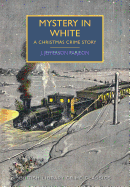
| Publisher: | British Library | |
| Genre: | General, Fiction, Mystery & Detective | |
| ISBN: | 9780712357708 | |
| Pub Date: | December 2014 | |
| Price: | $15 |
| Starred | Mystery & Thriller |
by J. Jefferson Farjeon
British crime novelist J. Jefferson Farjeon's Mystery in White was first published in 1937 and receives a brief introduction to accompany this new release. It's a classic puzzle, timeless even in its charming historic setting. A group of strangers gather in a third-class train compartment a few days before Christmas: an "elderly bore"; a young chorus girl; a clerk who "did not have spots, but looked as though he ought to have had"; a brother and sister; and an elderly scion of the Royal Psychical Society. When relentless snow shuts down the tracks, they flee an apparent murder on the train into the "strange fairyland" of whiteness outside. They happen upon a fine country estate, but the danger only mounts.
The door is unlocked, fires lit and tea set out; though no one appears to be home, the kettle is boiling over. This setting is not the closed environment it seems: in their investigations, members of the party tramp about in the snow only to find their footprints fade quickly and paths are obscured. The danger of losing oneself in the blizzard is added to the danger of knife-wielding lurkers.
Farjeon increases the pace and plays out suspense with an expert hand. His characters are appealing, their plight both picturesque and distressing; there is just a hint of the ghost story to this whodunit. Mystery in White is, in short, an elegantly, enchantingly entertaining tale to be enjoyed on a chilly evening while safely indoors. --Julia Jenkins, librarian and blogger at pagesofjulia
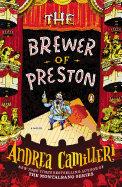
| Publisher: | Penguin Books | |
| Genre: | Humorous, General, Fiction, Mystery & Detective | |
| ISBN: | 9780143121497 | |
| Pub Date: | December 2014 | |
| Price: | $15 |
| Mystery & Thriller |
by Andrea Camilleri, trans. by Stephen Sartarelli
Published in Italian in the 1990s just as Andrea Camilleri was creating the first of his popular Inspector Montalbano mysteries, The Brewer of Preston is another of Camilleri's darkly comic Sicilian historical novels (Hunting Season) that take place a century earlier in the Inspector's fictional city of Vigàta. Translated for the first time into English, the book centers on the gala opening of the port city's new theater on December 12, 1874, shortly after the unification of Italy. The disastrous production of a Florentine opera--Il Birraio di Preston, about identical twins in an English brewery--forced on unsympathetic Sicilian townsfolk by corrupt Italian officials results in verbal abuse from the audience that becomes a riot and a fire that destroys not only the theater but the neighboring apartment house, causing the intervention of the militia and three deaths.
Sophisticated, carnal and wildly funny, Camilleri's depiction of that night is a farce on a grand scale. The tempestuous politics and convoluted scheming surrounding the doomed production are just as byzantine as any opera. Camilleri delights in double-talk, innuendo, blatant lies and double-crosses. In the final 40 pages, the surprises go off like a string of firecrackers, as the veneer of respectability is shattered. Nothing is what it seems, and for good measure Camilleri concludes his theater-in-flames disaster with a whitewashed official account "rewritten" 40 years later by one of the characters.
Ferociously cynical, Camilleri juggles more plot threads in this slim volume than could be found in a bulky trilogy, all of which converge at a gallop in a finale full of Sicilian laughter, horror and tears. --Nick DiMartino, Nick's Picks, University Book Store, Seattle, Wash.
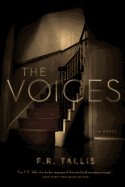
| Publisher: | Pegasus Crime | |
| Genre: | General, Suspense, Psychological, Fiction, Horror, Thrillers | |
| ISBN: | 9781605986562 | |
| Pub Date: | December 2014 | |
| Price: | $25.95 |
| Mystery & Thriller |
by F.R. Tallis
The Voices, a chilling tale of supernatural snooping by F.R. Tallis (The Sleep Room), is set in a well-off London neighborhood during the 1960s. When Christopher and Laura Norton move into their newly purchased and renovated old home with their four-month-old daughter, almost immediately they begin hearing strange things. Christopher, an avant-garde composer, is frustrated that his career has come to be defined by sci-fi music soundtracks; the ghostly voices--communications from the dead?--might be just what he needs to restart his more "serious" calling. Laura is simply terrified; she has always had accurate intuitions and now she is sure the voices are speaking her daughter's name. Christopher begins sampling the voices for what he hopes will be his career-saving masterpiece; but with what consequences?
On its surface, The Voices is a ghost story set in a haunted house. But its historical setting adds complexity: Laura, a former model, reads The Feminine Mystique and makes new female friends at bookstore readings, as Christopher studies the economic challenges facing his country and his household. Their marriage is threatened not only by the voices and the stress they bring but also the changing times and the family dynamics to which Tallis (a clinical psychologist) applies extra scrutiny. The Nortons' closest friends, also multifaceted, offer another layer of potential support, betrayal or suspense. With the added dimension of interpersonal relationships, this horror story is undeniably hair-raising. --Julia Jenkins, librarian and blogger at pagesofjulia

| Publisher: | Pegasus Books | |
| Genre: | Holocaust, History, Europe, World War II, Germany, Military | |
| ISBN: | 9781605986555 | |
| Pub Date: | December 2014 | |
| Price: | $29.95 |
| History |
by George M. Taber
Rarely can a story about central bankers, bullion holdings and maritime shipping be described as thrilling. Nazis, of course, tend to liven things up.
In times of economic and political chaos, gold becomes the last bastion of stability for individuals and countries. The Great Depression brought gold to the forefront of international economics in the 1930s, then Hitler's ambitions made gold holdings a matter of international security. The Nazis needed gold to finance their rearmament in the '30s and fuel their war machine during World War II. The Germans sought to steal the bullion of their invaded neighbors, precipitating the shipping of many thousands of tons of gold to bank vaults in the United States. Some bankers were caught by surprise, leading to an oft-repeated scene: brave bureaucrats desperately shuffling millions of dollars worth of gold just ahead of the advancing Wehrmacht. Outrunning Nazis was only the first obstacle--gold transport ships were still imperiled by prowling U-boats and naval mines. The Nazis also found a far more insidious source of gold in wedding bands and dental fillings stripped from concentration camp victims.
Journalist George M. Taber (The Judgment of Paris) chronicles the fortunes of Europe's gold before, during and after World War II in Chasing Gold: The Incredible Story of How the Nazis Stole Europe's Bullion. This exhaustive book glitters with an engaging narrative, though long descriptive passages of items like gold reserve tonnages occasionally weigh down the text. Taber gives enough broad historical information to keep general readers from getting lost, but the detailed depth of Chasing Gold seems most likely to appeal to history fans. --Tobias Mutter, freelance reviewer

| Publisher: | Pegasus Books | |
| Genre: | ||
| ISBN: | 9781605986524 | |
| Pub Date: | December 2014 | |
| Price: | $28.95 |
| History |
by Gordon Corrigan
By 1814, Napoleon had lost control of continental Europe: the French emperor was defeated by a coalition of other European powers, he abdicated the throne and he was forced into exile on the island of Elba off the Italian coast. The Bourbon monarchy, deposed decades earlier during the French Revolution, was restored to power. In 1815, Napoleon escaped Elba and retook the French throne, ushering in the Hundred Days period, during which he had a real chance of restoring France's lost imperial glory. Those hopes were dashed at the Battle of Waterloo on June 18, 1815, when a joint Anglo-Dutch-Prussian force decisively defeated Napoleon's army. The emperor abdicated and was exiled again, this time to Saint Helena in the mid-Atlantic, where he died in 1821.
That pivotal battle is the subject of Waterloo: A New History by British veteran and military historian Gordon Corrigan (A Great and Glorious Adventure; The Second World War). Corrigan spends the first half of the book establishing the history, people, places and equipment involved before giving a thrilling account of the battle itself. He is detailed enough to satisfy military history buffs without losing general readers, though the occasional listing of brigade numbers and minor officers might feel overwhelming. His prose is clear and engaging, sprinkled with gratifying details and footnotes revealing dry British humor. Waterloo should have a broad appeal to nonfiction readers, even those unfamiliar with the Napoleonic Wars. It is available in time for the battle's bicentennial this year. --Tobias Mutter, freelance reviewer

| Publisher: | Basic Books | |
| Genre: | Political Science, Iran, History, Biography & Autobiography, Women, World, Middle Eastern, Middle East | |
| ISBN: | 9780465069996 | |
| Pub Date: | December 2014 | |
| Price: | $27.99 |
| Current Events & Issues |
by Nazila Fathi
Nazila Fathi was nine years old when the 1979 Islamic Revolution occurred in Iran, replacing the Shah, Mohammad Reza Pahlavi, with Ayatollah Ruhollah Khomeini's hard-line Islamist government. For affluent, Westernized families such as Fathi's, the revolution brought terrifying changes: the loss of jobs, the banning of Western films and books and a sharp decline in personal freedoms (especially for women). But for millions of poor Iranians (male and female) who supported the new government, it meant economic opportunity and a chance to improve their place in society.
Fathi's memoir, The Lonely War, examines post-revolution Iran through the lens of her experience as a university student, a translator for American journalists and later the longtime Tehran correspondent for the New York Times. She explores the effects of the regime's harsh policies on ordinary Iranians, balancing stories of raids and imprisonment with chronicles of day-to-day life. She recounts interviews with top political figures, both pro- and anti-regime, and includes the opposing perspectives of political prisoners and regime supporters (such as her family's housekeeper).
During the 2009 popular uprisings, Fathi came under surveillance by the government. Forced to flee the country with her husband and children, she remains in exile, and her book is full of love and longing for the country she left behind. Fathi's memoir, like Iran's history, presents no easy answers to her country's political and social problems, but it paints a vivid portrait of a nation struggling to reinvent itself after years of oppression. --Katie Noah Gibson, blogger at Cakes, Tea and Dreams

| Publisher: | Tarcher | |
| Genre: | Diets, Health & Fitness, Diet & Nutrition, Nutrition, Healthy Living | |
| ISBN: | 9780399167966 | |
| Pub Date: | December 2014 | |
| Price: | $16.95 |
| Health & Medicine |
by Stefanie Sacks
If any title is going to entice readers to pick up a blueprint for healthy eating, it's the attention-grabbing What the Fork Are You Eating? by certified nutrition specialist Stefanie Sacks. Sacks is described as a "food warrior" for holding the food industry accountable, but calls herself a "moderationist" as she helps people replace toxic dietary choices with healthy alternatives. Her goal "isn't organic purity; it's getting rid of the crap."
To that end, she presents a primer on TRTs (Top Rated Terminators) that sabotage healthy diets--such as chemical preservatives, trans fats, antibiotics, hormones, GMOs and artificial flavors, colors and sweeteners--and explains why their GRAS (Generally Regarded As Safe) status awarded by the FDA is unacceptable. She then details how to rehab a pantry and refrigerator by interpreting food labels. Once the kitchen is cleared out, she provides an aisle-by-aisle action plan for finding healthy alternatives.
Sacks understands that while her readers may be receptive to her suggestions, entire families may not be. So she shares helpful tips for introducing new foods to kids and partners. More than 60 pages of nutritious recipes are included so readers know what to do with the new ingredients in the pantry and fridge. She also offers many helpful resources regarding the food industry (who owns major brands, who oversees what is considered humane, organic or sustainable, etc.). She wants us to make choices that send a loud and clear message to food companies: stop making humans science experiments. --Kristen Galles from Book Club Classics
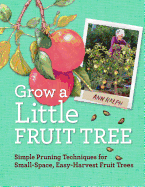
| Publisher: | Storey | |
| Genre: | Gardening, Trees, Techniques, Fruit | |
| ISBN: | 9781612120546 | |
| Pub Date: | December 2014 | |
| Price: | $16.95 |
| Gardening |
by Ann Ralph
Ann Ralph's Grow a Little Fruit Tree yields both a hands-on how-to for planting and tending a backyard orchard of judiciously pruned trees as well as a poetic homage to the bounty of nature. A fruit tree specialist with decades of nursery experience in central California and the Bay Area, Ralph shares her "evangelical zeal" for the benefits of small-scale trees: they require less space, offer manageable harvests and are sturdier and easier to tend than trees that soar out of reach.
The 12 chapter titles are illustrated on plant markers, one of the book's many graphic delights that also include photos, watercolors, literary quotes and sidebars; tiny drawings of insects, seeds and shears accompany the page numbers. Ralph takes the aspiring tree-pruner from a convincing introduction through pruning principles, choosing varieties, the critical first cut, watering and maintenance, and includes advice on apples, figs, cherries, apricots and more. Anecdotes reinforce Ralph's persona as a knowledgeable neighbor eager to help: her grandfather planted a tree at age 96 ("fruit trees are about the future"); she has strategized around thieving birds, deer, raccoons and squirrels ("just grow more fruit" works); her family savors the grapefruit from her late parents' tree.
While this handbook grows out of Ralph's California experience, the rules and encouragement apply anywhere, and she notes the "chill science" and varieties a gardener "in whatever region you call home" needs to know. Bursting with tips and advice, this enthusiastic directory to succulent homegrown fruit is something even an apartment dweller can enjoy. --Cheryl Krocker McKeon, manager, Book Passage, San Francisco

| Publisher: | Open Letter Books | |
| Genre: | Literary Criticism, Literary Collections, General, Social Science, Subjects & Themes, Poetry, Feminism & Feminist Theory, Russian & Former Soviet Union | |
| ISBN: | 9781940953021 | |
| Pub Date: | December 2014 | |
| Price: | $12.95 |
| Poetry |
by Olga Sedakova, trans. by Ksenia Golubovich, Caroline Clark, Stephanie Sandler
Olga Sedakova (Poems and Elegies) began writing poetry at an early age. In the 1970s, when the Soviet government preferred she and her fellow Russian poets cease their art, they went underground. Until 1990, her poetry was available only as samizdat--handwritten copies that were secretly passed from reader to reader. The '90s brought dramatic change and her work was widely published in Russian. Thanks to a group of translators and Open Letter Books, some of her work and her ideas about art and poetry are now available to English-speaking readers.
In Praise of Poetry is a potpourri. There are two sections of her poetry: "Old Songs," a group of early, individual pieces, and poems from her "Tristan and Isolde" sequence. Also included is her essay "In Praise of Poetry," an interview and her brief acceptance speech for her 2011 Master's Prize in Translation (on Rilke and Eliot: "These I love and I want to convey my love for them to Russian readers").
Her poetry draws deeply on Russian cultural and religious traditions. Poems in the first section reveal a deceptive, prayer-like simplicity, a piety reflective of monastic chroniclers. The opening piece in "Tristan and Isolde" invites us to "sew a dress of darkness,/ a monk's cloak of old." Purposefully avoiding the story's famous plot, she offers up poetic digressions, an act that she calls "tracing out of the air." These are rich, thoughtful, meditative poems exquisitely rendered. --Tom Lavoie, former publisher
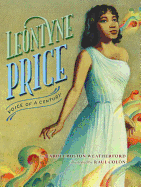
| Publisher: | Knopf | |
| Genre: | Juvenile Nonfiction, Cultural Heritage, Biography & Autobiography, Women, Music | |
| ISBN: | 9780375856068 | |
| Pub Date: | December 2014 | |
| Price: | $17.99 |
| Starred | Children's & Young Adult |
by Carol Boston Weatherford, illust. by Raúl Colón
Carol Boston Weatherford (Africa Dream) begins this inspiring picture book biography of the groundbreaking soprano in 1927 Laurel, Miss., where "the line between black and white was as wide as the Mississippi River was long," and demonstrates how Leontyne Price broke barrier after barrier in a society largely hostile to African Americans.
Raúl Colón (Draw) reflects Price's journey through a palette of the earthen browns and creams of the Cotton Belt where she grew up. The music that moved and emanated from Price infuses the scenes in a swirl of rainbow colors. Still a girl, Leontyne watches Marian Anderson "[glide] onstage in a whoosh of satin." Author and artist here link the lives of the two singers, laying out how one paved the way for the other. A stream of colors envelops Anderson like a low-lying mist, "Her song, like a torch, sparked a light in Leontyne." In 1939, as Anderson sings the famous Easter concert at the Lincoln Memorial, young Leontyne sings in her church choir on the facing page. Her college president hears Leontyne sing and urges her to study voice: "Led by song, she cracked the door that Marian had opened years earlier."
The author chronicles how Price's voice led to Juilliard, Broadway and finally to New York's Metropolitan Opera House, against the backdrop of a United States where much remained closed to her. Weatherford describes the journey that built Price's personal and professional strength and power; Colón makes visible the music that fueled her path. --Jennifer M. Brown, children's editor, Shelf Awareness

| Publisher: | Little, Brown | |
| Genre: | Boys & Men, Juvenile Nonfiction, General, Sports & Recreation, Humor, Biography & Autobiography, Dating & Sex, Social Issues, Health & Daily Living, Physical Impairments, Olympics | |
| ISBN: | 9780316251020 | |
| Pub Date: | December 2014 | |
| Price: | $18 |
| Children's & Young Adult |
by Josh Sundquist
At age nine, Josh Sundquist was diagnosed with cancer and had his left leg amputated at the hip. This memoir leads readers through a charmingly honest catalogue of his past almost-girlfriends.
Josh opens in eighth grade with a wicked crush on Sarah Stevens. He describes the universal pains of middle-school crushes--putting your BFF up to finding out if your crush is mutual and your crush's BFF serving as messenger back, and requited crushes that fizzle out before they even begin. Sundquist uses charts, graphs, footnotes and Venn diagrams to ramp up the deadpan humor. His prologue sets the tone: "When I was twenty-five years old, it came to my attention that I had never had a girlfriend." His clear-eyed observations about his family and the young women to whom he's attracted will entertain and pierce readers, in equal measure. On his first day of public school in ninth grade, an upper-classman trips Josh, and he describes his step-by-step process of righting himself with his prosthesis. We see how he goes to great lengths to abide by his two rules: 1. Never be a burden. 2. Never be different.
After Josh's description of each would-be girlfriend encounter, he hypothesizes about why things didn't work out, then launches an investigation (he tracks down the almost-girlfriend to test each hypothesis). Some investigations are inconclusive, others non-events; with still others, such as prom date Evelyn, Josh learns that things might have worked out if he'd read the signals properly. Best of all, his story has a happy ending. --Jennifer M. Brown, children's editor, Shelf Awareness
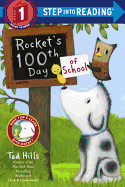
| Publisher: | Schwartz & Wade/Random House | |
| Genre: | Animals, School & Education, Readers, Dogs, Juvenile Fiction, Beginner | |
| ISBN: | 9780385390972 | |
| Pub Date: | December 2014 | |
| Price: | $3.99 |
| Children's & Young Adult |
by Tad Hills
The lovable canine hero Rocket adds counting to his list of talents in Tad Hills's second Step into Reading entry, after Drop It, Rocket!
To celebrate the 100th day of school, Rocket begins collecting "100 special things." He finds the perfect spot to keep them--in the hollow of a tree. "Or maybe not," says the text, as a squirrel pokes out of the hole, nose to nose with Rocket. Luckily, the squirrel is friendly. "You can keep your things here," says Bella. Hills shows the interior of the squirrel's spot, as Rocket peers through the opening. Mindful of building a beginning reader's skills, Hills repeats the sentence structure with a series of vignettes: "Rocket finds pencils./ He finds a book./ He finds acorns." The pup's followers will recognize his pals from previous adventures, including Mr. Barker, who helps collect heart-shaped stones, and Emma, Fred and Owl, who also assist Rocket. "He puts everything in the tree," including all 26 letters of the alphabet, which Rocket records on individual cards.
On the 100th day of school, Rocket tallies on a blackboard everything he'd placed in the tree. But wait! There are only 95 things! "Where are the acorns?" Rocket asks. The guilty party's confession is worth the price of admission. Not only does Rocket forgive her, he also comes up with a solution to reach a perfect 100. With a smidge of math and a lot of heart, this beginning reader is sure to please Rocket's fans and win him new ones. --Jennifer M. Brown, children's editor, Shelf Awareness